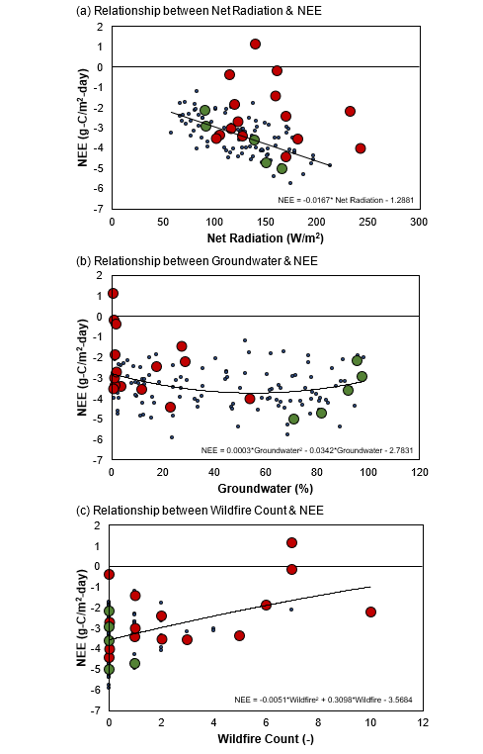

Release date: 2024.03.13
Taipei – "When Forests Hold Their Breath" is the latest study from Academia Sinica, conducted in partnership with international researchers. It arrives at a pivotal moment, as reported by major news outlets like NPR, BBC, and Al Jazeera, when Taiwan’s unprecedented drought in recent years has caught the world’s attention for its economic impact on the semiconductor industry, highlighting a deep environmental crisis.
The study, which meticulously combines in-situ data, advanced satellite observations, and ecological data analysis, reveals the drastic effects of severe drought on wildfire and the carbon sequestration capacity of Taiwan's subtropical forests. At a time when the island nation's high-tech sector faced critical shortages due to water scarcity—a unique challenge of its own—the research also points to an ecological emergency: stressed forests and widespread fires releasing more carbon than they absorb, thus ceasing their inherent function as a carbon sink.
Yi-Ying Chen from Academia Sinica underscores the global resonance of this phenomenon, “The drought in Taiwan, as reported by NPR, not only disrupted the chip industry, essential for our everyday technology but also signaled a dire environmental shift. Our study echoes these concerns, emphasizing the broader impact on our forests’ health and their critical role in carbon absorption.”
As BBC News has highlighted, Taiwan is typically a region abundant with rainfall, yet recent climatic shifts have led to the worst drought and the costliest fires in 56 years, with reservoirs dropping to alarming levels. This change in weather patterns has had substantial repercussions, as the new study indicates, on the traditional carbon sinks, suggesting a worrying trend for curbing future climate warming.
The Wall Street Journal's coverage of Taiwan's drought illustrates the gravity of the situation, citing experts who warn of the increasing severity of droughts and longer dry periods. The research team at Taiwan's institutes and Utah State University echoes this sentiment, presenting advanced analysis that vividly demonstrates the forests' reduced ability to function as carbon sinks during these dry spells.
Simon Wang of Utah State University, part of the research collective, adds, “The drought's impact on Taiwan’s chip manufacturing has been substantial, as Al Jazeera reported, but the potential long-term environmental implications are equally significant. Our study highlights that without intervention, these drought patterns may become a new normal, with profound implications for global carbon cycles.”
The research suggests that strategies for forest management and climate mitigation must be urgently revised to accommodate these changes. "Our forests are facing unprecedented challenges," states Wan-Yu Liu, the corresponding author from National Chung Hsing University. "In line with the Intergovernmental Panel on Climate Change's recent findings, as noted by The New York Times, our work serves as a crucial indicator of the immediate need for climate action."
In bringing this study to the forefront through an international partnership, these institutions aim to catalyze academic conversation on the nexus between climate change, ecosystem health, and technological reliance. This dialogue has been underscored by the recent media spotlight on the unexpected consequences of drought in Taiwan, home to the world's major chipmakers. The study represents a comprehensive call to acknowledge and prepare for the escalating challenges that climate change poses to our natural world and its capacity to sustain human progress.
For a deeper understanding of the study and its implications, interested parties are encouraged to contact the Public Relations Office at Academia Sinica.
Acknowledgments: We extend special thanks to the National Science and Technology Council of the Executive Yuan, the Lien-Hua-Chich Branch of the Forestry Experimental Institute of the Ministry of Agriculture, and the long-standing support from the National Central University's Institute of Hydrological and Oceanic Sciences for the maintenance of the on-site flux observation system. We also appreciate the provision of long-term forest fire data by the Forestry and Nature Conservation Administration of the Ministry of Agriculture.

Historical Wildfire Distribution during 2012-2022 in Taiwan (map) and Time Series of NEE (a), Groundwater (b), Wildfire Count (c), where contains monthly value (bars) and 4-month moving average (lines, centered). The Lien-Hua-Chih Hydrometeorological Observatory is located at the center of the 45-km circle that includes the wildfires in (c).

1 Red dots indicate the epicenter of major droughts (2015 Feb-Jun, 2020 Feb-Jun, 2021 Feb-Jun); Green dots indicate the epicenter of NEE drops (2016 Feb-Jun); Blue dots indicate the rest of the period. 2 The trend line in Figure a is calculated excluding the samples represented by red dots. Scatter diagrams between NEE and Groundwater (a), Net Radiation (b), and Wildfire Count (c).